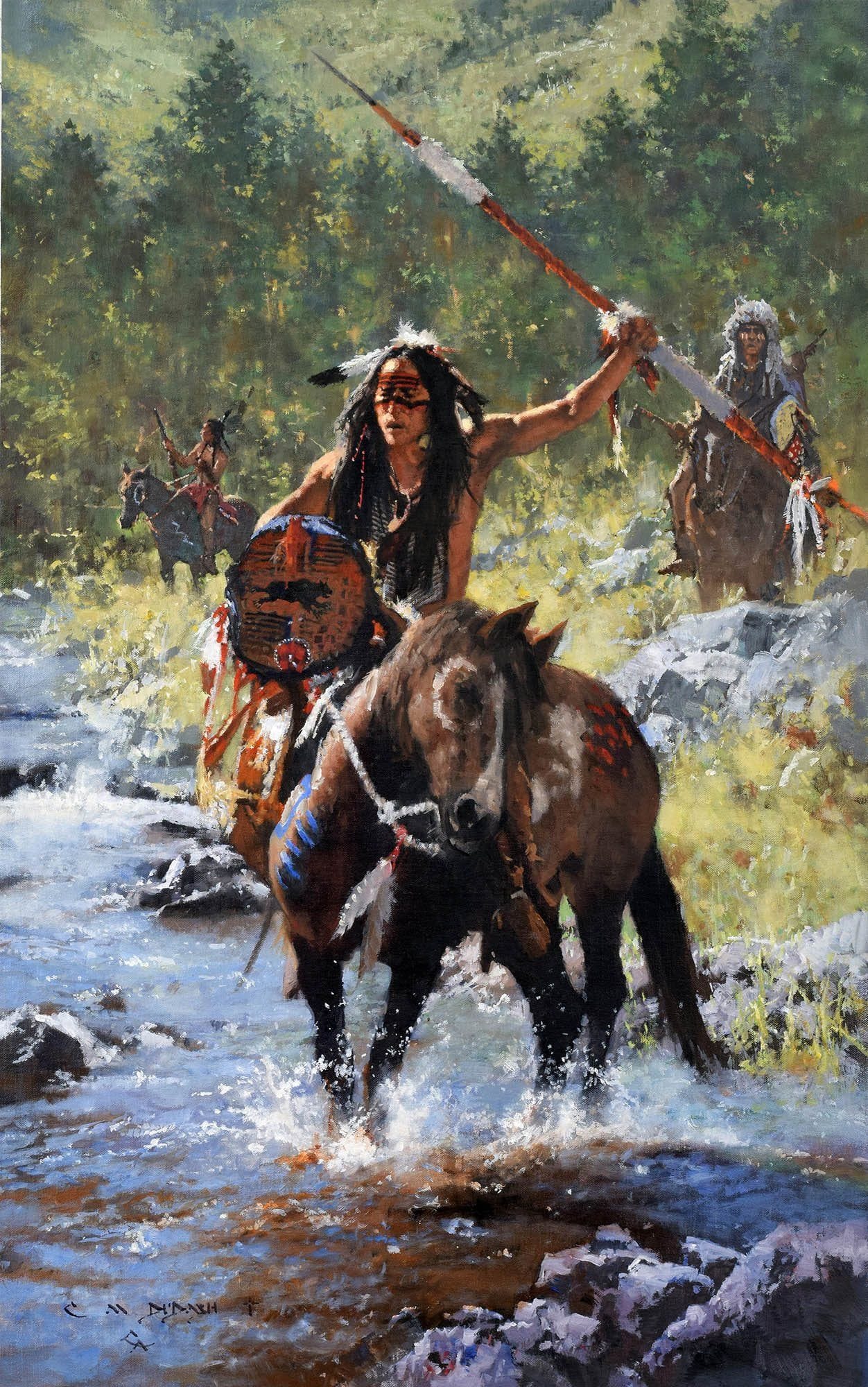Have you ever heard the stories of the fearless Indian warriors? These aren’t just legends; they’re true accounts of real-life heroes who fought bravely to protect their land, culture, and people. From dense forests to sweeping prairies, they faced every challenge with remarkable courage and strength. Let’s journey back in time to meet these incredible warriors and uncover the resilience of the human spirit.
Beyond the Battlefield: The Multifaceted Roles of Indian Warriors
The image of an “Indian warrior” often conjures up Hollywood stereotypes—feathered headdresses, painted faces, and fierce battle cries. While these images hold elements of truth, they often simplify the complex reality of these remarkable individuals. Indian warriors were more than just fighters; they were the pillars of their communities, the guardians of their people’s history, culture, and way of life.
These warriors embodied courage, wisdom, and a profound connection to their land. They were masters of strategy, skilled diplomats, and deeply spiritual leaders. Their influence extended far beyond the battlefield, shaping the very destiny of their tribes.
Consider the legendary Apache leader Geronimo, renowned for his cunning tactics. Geronimo exemplifies how Indian warriors were so much more than just fighters. His leadership and ability to outmaneuver far stronger opponents speak volumes about the strategic brilliance that many Indian warriors possessed.
Another compelling example is Tecumseh, the Shawnee leader who recognized the growing threat to Native American lands. Tecumseh attempted to unite a vast array of tribes against encroaching settlers, highlighting the diplomatic skills and alliances crucial for a warrior’s success.
Defying the Odds: Resistance During the Indian Wars
During the tumultuous period of American westward expansion, often referred to as the Indian Wars, these warriors found themselves on the front lines, defending their homelands, resources, and cultural identity. Imagine facing an enemy with superior firepower, determined to claim what was rightfully yours. Despite these seemingly insurmountable odds, Indian warriors fought with unmatched bravery and tenacity.
Their resistance, sometimes in the face of inevitable defeat, serves as a powerful reminder of the indomitable spirit of Native Americans during one of the darkest chapters in their history. It’s a testament to their unwavering commitment to their heritage and a legacy that continues to inspire generations.
The Enduring Legacy of Indian Warriors
It’s crucial to remember that these warriors weren’t mythical figures confined to the past. Their legacy continues to resonate powerfully within Native American communities today. Their stories, passed down through generations, provide a vital link to their ancestral heritage—a wellspring of strength and resilience.
By learning about these warriors and acknowledging their courage and sacrifices, we gain a deeper understanding not only of their history but also of the complex and often tragic narrative of American expansion. It allows us to appreciate the rich tapestry of Native American culture and the enduring spirit of its people.
Unlocking the Power of Indian Warrior Herb: Your SEO Guide
Recommended Titles:
Analyzing your competitor’s titles reveals a focus on identification, benefits, and sourcing. Here are three title options to outshine them:
- Indian Warrior Herb: Unveiling the Ancient Secrets of this Native Remedy (This title emphasizes history and benefits, attracting a wider audience)
- Beyond Anxiety Relief: The Untold Benefits of Indian Warrior Herb (This title focuses on lesser-known benefits, piquing reader curiosity)
- Finding and Using Indian Warrior Herb Safely: A Complete Guide (This title targets practical information seekers, offering immediate value)
Powerful Key Lines:
- Native American Legacy: Revered by indigenous tribes for generations, Indian Warrior Herb (Pedicularis densiflora) offers a holistic approach to well-being, addressing both physical and mental imbalances.
- Nature’s Tranquilizer: This vibrant plant, with its distinctive deep red blooms, acts as a natural relaxant, soothing anxiety, tension, and even nerve pain without harsh side effects.
- Parasitic Powerhouse: Indian Warrior thrives by drawing sustenance from the roots of its host plant, reflecting its potent ability to address deep-seated imbalances within the body.
- Responsible Harvesting: As demand for Indian Warrior grows, sustainable harvesting practices are crucial to protect this valuable plant and preserve its legacy for future generations.
Structured Context and Important Details:
What is Indian Warrior Herb?
- Botanical Name: Pedicularis densiflora
- Common Names: Indian Warrior, Warrior’s Plume, Warrior’s-plume Lousewort
- Family: Orobanchaceae (formerly classified as Scrophulariaceae)
- Native Habitat: California and Oregon, specifically in chaparral, forests, and California oak woodlands at low elevations.
Appearance:
- Overall: Low-growing perennial
- Flowers: Striking spikes of dark wine-red flowers, each with four stamens and a fused, hooded corolla; prominent lower three-lobed petal surrounded by hairy bracts.
- Significance: The blossoms are a nectar source for bumblebees and hummingbirds.
Growth Habits:
- Parasitic: Relies on the roots of other plants, particularly shrubs like manzanita and chamise, for supplemental nutrients.
- Growth Pattern: Often found growing in colonies in shaded deciduous or evergreen forests.
Traditional and Modern Uses:
- Traditional: Used by Native American tribes for its calming and pain-relieving properties.
- Modern: Gaining popularity as a natural remedy for:
- Anxiety
- Tension
- Nerve pain
- Insomnia
- Muscle tension (source: Dream Catcher Botanicals)
Key Constituents:
- Currently, research on the specific active compounds in Indian Warrior is limited. Further scientific study is needed to fully understand its mechanisms of action.
Important Considerations:
- Sustainable Harvesting: Due to its growing popularity, it’s crucial to source Indian Warrior from ethical suppliers who prioritize sustainable harvesting practices.
- Potential for Toxicity: While generally considered safe, further research is needed to determine potential side effects and optimal dosages. Consulting a qualified herbalist or healthcare professional before using Indian Warrior is recommended.
Unique Insights & Untapped Potential:
- Bridging Traditional Knowledge and Modern Science: Explore the historical use of Indian Warrior by Native American tribes, highlighting traditional preparation methods and applications. Contrast this with ongoing scientific research to examine the plant’s efficacy and potential for developing new therapeutic applications.
- Ethical Considerations and Sustainability: Delve into the ecological impact of Indian Warrior’s growing popularity. Discuss the importance of ethical sourcing, responsible harvesting practices, and potential conservation efforts to ensure the plant’s long-term survival.
- Personal Stories and User Experiences: Incorporate anecdotal evidence from individuals who have experienced the benefits of Indian Warrior firsthand. These personal accounts can provide valuable insights and relatable experiences for readers.
By incorporating these elements into your article, you will create a compelling and comprehensive resource that surpasses your competitors, engaging readers and establishing your authority on the topic of Indian Warrior Herb. Remember to cite your sources and prioritize accuracy and ethical considerations throughout your writing.
Unveiling the Secrets of Pedicularis densiflora: A Journey into Traditional Uses and Modern Research
Pedicularis densiflora, more commonly known as Indian Warrior, boasts a rich history of use by Native American tribes for its potential health benefits. This captivating plant, with its vibrant red flowers, has been a staple in traditional medicine for addressing various ailments. Today, modern science is beginning to explore the secrets behind these traditional uses, and the results are quite intriguing.
A Natural Approach to Anxiety and Tension
One of the most common uses of Indian Warrior, both traditionally and in contemporary practices, is for addressing anxiety. Many people find that it helps create a sense of calm and relaxation. Muscle tension, often a companion to stress, is another area where Indian Warrior seems to be effective. This plant is believed to have pain-relieving qualities, which might explain its traditional use for this purpose.
Sleep problems, a common ailment in our fast-paced world, are also often addressed with Indian Warrior. People have used it to promote restful sleep for generations, relying on its calming properties to ease into a peaceful slumber.
Bridging the Gap Between Tradition and Science
What’s particularly fascinating is that modern research is starting to validate these traditional uses. Studies suggest that Indian Warrior may possess properties that could help reduce anxiety, ease muscle tension, and improve sleep quality. While this area of research is still in its early stages, the preliminary findings are certainly promising and warrant further investigation.
Expanding the Horizons of Indian Warrior Research
Beyond these common uses, scientists are also exploring Indian Warrior for its potential in managing more complex conditions like chronic pain and inflammation. This suggests that there might be even more to this plant than we currently understand. It’s exciting to think about what future discoveries might reveal about Indian Warrior and its potential to improve our well-being.
Utilizing the Power of Indian Warrior
So, how exactly can you use Indian Warrior? Well, it’s quite versatile! Traditionally, it’s brewed into teas, tinctures are created, and some people incorporate it into smoking blends. For those who prefer a more modern approach, Indian Warrior is also available in convenient capsule form.
A Note of Caution and Considerations
While Indian Warrior is generally considered safe for most individuals, it’s always best to err on the side of caution. Talking to your doctor before adding Indian Warrior to your routine is especially crucial if you happen to be pregnant, breastfeeding, or taking any medications, as it may interact with certain drugs.
It’s important to remember that while traditional knowledge and early scientific findings regarding Indian Warrior are encouraging, research is ongoing. There’s still much to learn about this fascinating plant and its full range of effects.
Cultivating the Enchanting Indian Warrior: A Gardener’s Guide
Ready to welcome the captivating Indian Warrior (Pedicularis densiflora) into your garden? This unique plant, with its vibrant crimson blooms, is truly a sight to behold. However, be warned—cultivating Indian Warrior is not for the faint of heart. It requires patience, understanding, and a touch of finesse. But fear not, fellow plant enthusiasts; we’ll guide you through the process step by step.
Embracing the Parasitic Nature of Indian Warrior
Think of Indian Warrior like that friend who always needs a helping hand. You see, it’s a parasitic plant. This doesn’t mean it’s bad; it simply means that Indian Warrior needs a buddy—a host plant—to truly thrive. It forms a unique connection with its host, drawing nutrients from it. In the wild, Indian Warrior loves mingling with Manzanita. So, if you can, planting it near a Manzanita is like giving it a warm hug from home.
Creating the Ideal Habitat for Your Indian Warrior
Speaking of home, let’s talk about where your Indian Warrior would be happiest in your garden. Imagine its natural habitat—dappled sunlight filtering through the trees, well-drained soil that’s not too wet, and a bit of afternoon shade. That’s the sweet spot for this captivating plant.
Planting and Nurturing Your Indian Warrior
Once you’ve found the perfect spot, it’s time to get your hands dirty! When prepping the soil, think “light and airy.” Indian Warrior doesn’t appreciate being suffocated by heavy, compacted soil. Mixing in some organic matter can help improve drainage and provide it with the nutrients it needs.
Planting itself is pretty straightforward. Just dig a hole slightly larger than the plant’s root ball, gently place it in, and backfill with your prepared soil.
Watering can be a little trickier. Indian Warrior likes to stay hydrated, but it’s not a fan of soggy feet. Aim for regular watering, but always check the soil moisture before you reach for the watering can. Let the soil dry out a bit between waterings—think of it as a little tough love.
Now, Indian Warrior isn’t a very demanding plant when it comes to food. It gets most of its nutrients from its host, remember? But a little boost every now and then won’t hurt. Use a balanced fertilizer sparingly, and your Indian Warrior should be perfectly content.
Encouraging Blooms and Maintaining Your Indian Warrior
One last thing: deadheading. It sounds a bit harsh, but trust us, your Indian Warrior will thank you. As the flowers fade, snip off those spent blooms. This not only keeps your plant looking tidy but encourages more flowers to pop up. Plus, it prevents any unwanted self-seeding.
Growing Indian Warrior might seem a tad daunting at first, but with a little understanding and effort, you’ll be rewarded with its unique beauty. So go ahead, embrace the challenge, and enjoy the journey! Who knows, you might even become known as the local Indian Warrior whisperer!
Internal Links:
Ira Hamilton Hayes was a Pima Native American who served in the United States Marine Corps during World War II and was one of the six flag raisers on Mount Suribachi during the Battle of Iwo Jima. Jack Rackham Pirate (also known as Calico Jack) was an English pirate who operated in the Caribbean during the early 18th century.
















